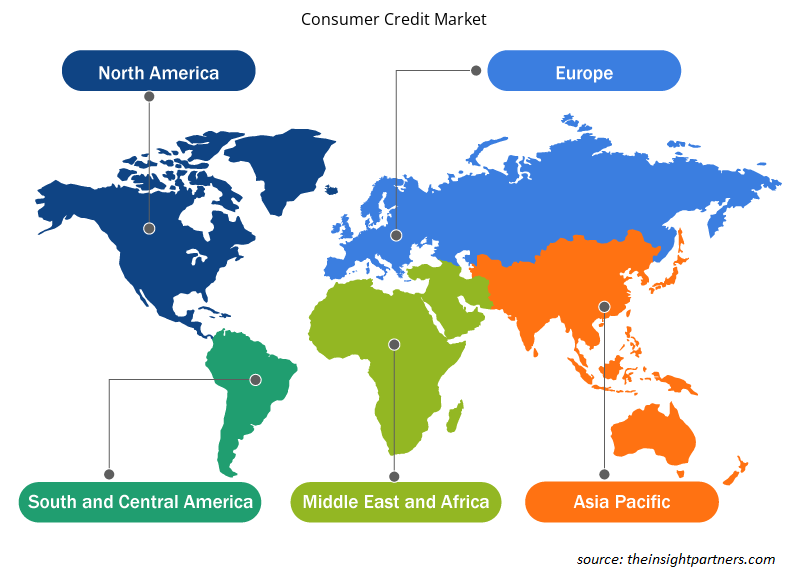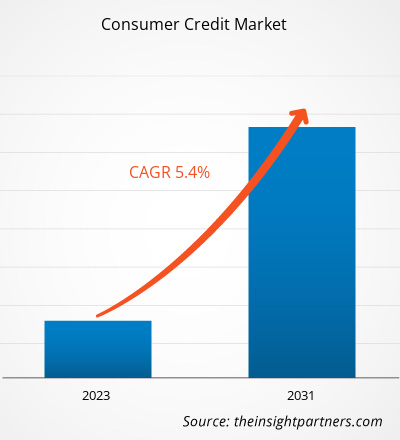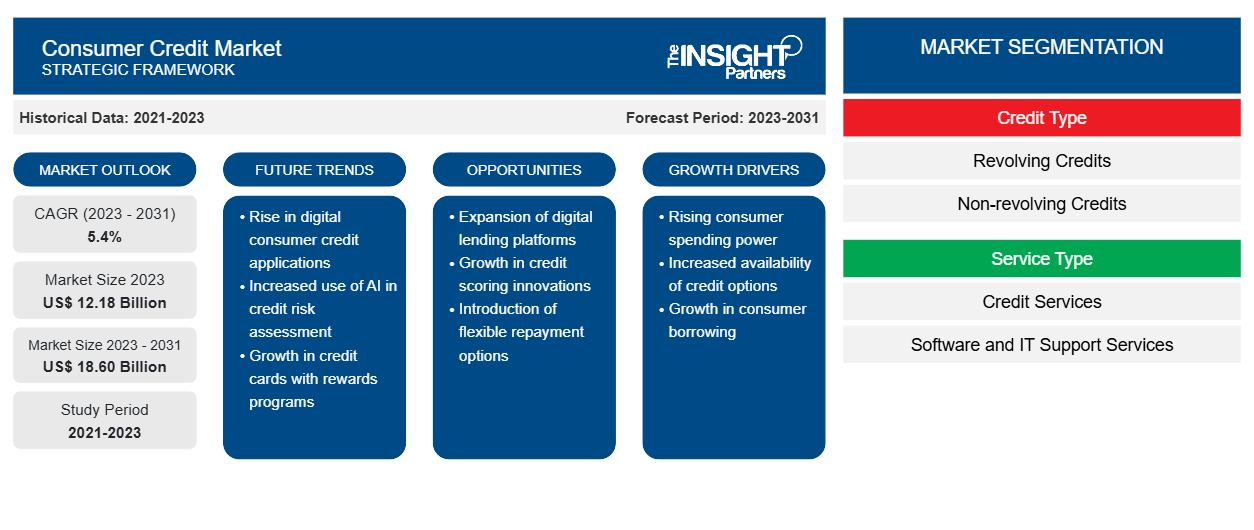Si prevede che le dimensioni del mercato del credito al consumo cresceranno da 12,18 miliardi di $ nel 2023 a 18,60 miliardi di $ entro il 2031; si prevede che si espanderà a un CAGR del 5,4% dal 2023 al 2031. Il credito al consumo, spesso noto come debito al consumo, è un debito personale contratto per acquisire beni o servizi. Sebbene qualsiasi tipo di prestito personale possa essere classificato come credito al consumo, la frase è più comunemente utilizzata per indicare un debito non garantito in piccole somme. Le statistiche sul credito al consumo sono un indice chiave per monitorare la salute di un'economia. Trasmette il potere di spesa di un consumatore in una particolare economia.
Analisi del mercato del credito al consumo
Il credito è un importante abilitatore di consumo per i clienti che altrimenti non sarebbero in grado di permettersi un prodotto particolare. Poiché sempre più persone fanno acquisti online, soluzioni digitali innovative per la finanza al punto vendita, spesso progettate da aziende tecnologiche agili e integrate senza soluzione di continuità nel percorso del cliente, stanno guadagnando popolarità tra gli acquirenti della generazione Y che sono cauti riguardo alle inadeguate capacità digitali delle banche tradizionali. I progressi tecnologici e la regolamentazione di supporto hanno reso più facile per questi nuovi concorrenti interrompere il controllo delle banche tradizionali sulla catena del valore dei prestiti e competere sulla base di una fornitura di servizi più rapida, personalizzata ed efficiente. La lealtà e l'inerzia che in precedenza legavano i consumatori alle loro banche stanno svanendo in tutta Europa, poiché la regolamentazione ha reso più facile che mai creare partnership con diversi fornitori di servizi finanziari.
Credito al consumo
Panoramica del settore
- Alcuni dei principali fattori che guidano la crescita del mercato del credito al consumo sono il cambiamento degli stili di vita urbani, la rapida proliferazione dell'e-commerce in tutte le regioni del mondo, i progressi tecnologici e altri. Ad esempio, l'introduzione dell'intelligenza artificiale cambierà il processo fondamentale del prestito al consumo. La tecnologia AI è progettata per migliorare e semplificare le attività amministrative, consentendo ai dipendenti delle banche di dedicare più tempo alle relazioni con i clienti. Le interazioni basate sull'AI consentono un onboarding dei clienti senza interruzioni e tempi di risposta ridotti per le attività di rischio e conformità. Le esperienze positive dei consumatori possono aumentare la fedeltà e i referral dei clienti.
- L'attività di credito al consumo di un paese dipende in larga misura dal comportamento di spesa di un consumatore nel paese. Ad esempio, la spesa delle carte di credito dei consumatori è aumentata solo del 4,1 percento anno su anno nel 2023 nel Regno Unito, molto al di sotto della crescita osservata nel 2022 (10,6 percento), poiché i britannici hanno ridotto i vestiti nuovi, le cene fuori e i lavori di ristrutturazione della casa a causa della crescente inflazione e dei costi familiari. I consumatori, d'altro canto, hanno continuato a dare priorità ai momenti di piacere e alle esperienze condivise, guidando la crescita nei viaggi, nell'intrattenimento e nei pub e bar.
Personalizza questo report in base alle tue esigenze
Riceverai la personalizzazione gratuita di qualsiasi report, comprese parti di questo report, o analisi a livello nazionale, pacchetto dati Excel, oltre a usufruire di grandi offerte e sconti per start-up e università
-
Scopri le principali tendenze di mercato in questo rapporto.Questo campione GRATUITO includerà analisi di dati che spaziano dalle tendenze di mercato alle stime e alle previsioni.
Driver del mercato del credito al consumo
Richiesta di flessibilità nella spesa per guidare il mercato del credito al consumo
- Offrire prestiti al consumo aumenta la conversione offrendo la flessibilità che i clienti di oggi desiderano. Secondo il Millennial Money Survey del Foreign & Colonial Investment Trust, il 16% dei millennial non risparmia denaro ogni mese e 7,8 milioni non hanno alcun risparmio.
- I Millennials spesso danno più valore a esperienze come viaggi, cene fuori e intrattenimento rispetto alla proprietà di beni tradizionali come case e automobili. Di conseguenza, gli individui potrebbero fare più affidamento su carte di credito e prestiti personali per finanziare queste esperienze, alimentando la domanda nel mercato del credito al consumo.
Credito al consumo
Analisi della segmentazione del rapporto di mercato
- In base alla tipologia di credito, il rapporto sul mercato del credito al consumo è suddiviso in crediti revolving e crediti non revolving.
- Il credito revolving, che include le carte di credito, può essere utilizzato per qualsiasi acquisto. Il credito è "revolving" nel senso che la linea di credito rimane aperta e può essere utilizzata fino al limite massimo ripetutamente, finché il mutuatario continua a effettuare puntualmente il pagamento mensile minimo.
Credito al consumo
Analisi di mercato per area geografica
L'ambito del rapporto sul mercato del credito al consumo è principalmente suddiviso in cinque regioni: Nord America, Europa, Asia Pacifico, Medio Oriente e Africa e Sud America. Il Nord America sta vivendo una rapida crescita e si prevede che detenga una quota significativa del mercato del credito al consumo. Il significativo sviluppo economico della regione, la crescita della popolazione e la crescente attenzione alla gestione del rischio e all'assicurazione hanno contribuito a questa crescita. Il Nord America ospita molti paesi in via di sviluppo come gli Stati Uniti e il Canada, che guidano la crescita del mercato del credito al consumo.
Credito al consumo
Approfondimenti regionali sul mercato del credito al consumo
Le tendenze regionali e i fattori che influenzano il mercato del credito al consumo durante il periodo di previsione sono stati ampiamente spiegati dagli analisti di Insight Partners. Questa sezione discute anche i segmenti e la geografia del mercato del credito al consumo in Nord America, Europa, Asia Pacifico, Medio Oriente e Africa, e Sud e Centro America.

- Ottieni i dati specifici regionali per il mercato del credito al consumo
Ambito del rapporto sul mercato del credito al consumo
| Attributo del report | Dettagli |
|---|---|
| Dimensioni del mercato nel 2023 | 12,18 miliardi di dollari USA |
| Dimensioni del mercato entro il 2031 | 18,60 miliardi di dollari USA |
| CAGR globale (2023-2031) | 5,4% |
| Dati storici | 2021-2023 |
| Periodo di previsione | 2023-2031 |
| Segmenti coperti |
Per tipo di credito
|
| Regioni e Paesi coperti |
America del Nord
|
| Leader di mercato e profili aziendali chiave |
|
Densità degli operatori del mercato del credito al consumo: comprendere il suo impatto sulle dinamiche aziendali
Il mercato del credito al consumo sta crescendo rapidamente, spinto dalla crescente domanda degli utenti finali dovuta a fattori quali l'evoluzione delle preferenze dei consumatori, i progressi tecnologici e una maggiore consapevolezza dei vantaggi del prodotto. Con l'aumento della domanda, le aziende stanno ampliando le loro offerte, innovando per soddisfare le esigenze dei consumatori e capitalizzando sulle tendenze emergenti, il che alimenta ulteriormente la crescita del mercato.
La densità degli operatori di mercato si riferisce alla distribuzione di aziende o società che operano in un particolare mercato o settore. Indica quanti concorrenti (operatori di mercato) sono presenti in un dato spazio di mercato in relazione alle sue dimensioni o al valore di mercato totale.
Le principali società che operano nel mercato del credito al consumo sono:
- American Express
- Banca degli Stati Uniti
- Città
- Banca Wells Fargo
- Banca Capitale Uno
Disclaimer : le aziende elencate sopra non sono classificate secondo un ordine particolare.

- Ottieni una panoramica dei principali attori del mercato del credito al consumo
"Analisi del mercato del credito al consumo"è stato condotto in base alle strategie di investimento principali e alla geografia. In termini di tipo di credito, il mercato è segmentato in crediti revolving e crediti non revolving. In base alla geografia, il mercato è segmentato in Nord America, Europa, Asia Pacifico, Medio Oriente e Africa e Sud America.
Credito al consumo
Notizie di mercato e sviluppi recenti
Le aziende adottano strategie inorganiche e organiche come fusioni e acquisizioni nel mercato del credito al consumo. Di seguito sono elencati alcuni recenti sviluppi chiave del mercato:
- A febbraio 2024, Barclays PLC e Blackstone Credit & Insurance hanno annunciato oggi che Barclays Bank Delaware ha stipulato un accordo con conti assicurativi gestiti dal gruppo Asset Based Finance di Blackstone per vendere circa 1,1 miliardi di dollari USA di crediti da carte di credito attualmente in sospeso in relazione a un set definito di conti di carte di credito a marchio Barclays negli Stati Uniti d'America. Questa è la prima di una serie di attività che Barclays prevede di condurre per ridurre i suoi asset ponderati per il rischio (RWA) e creare ulteriore capacità di prestito per BBDE.
[Fonte: Barclays PLC, sito web aziendale]
Credito al consumo
Copertura e risultati del rapporto di mercato
Il rapporto di mercato "Dimensioni e previsioni del mercato del credito al consumo (2021-2031)" fornisce un'analisi dettagliata del mercato che copre le seguenti aree:
- Dimensioni e previsioni del mercato a livello globale, regionale e nazionale per tutti i principali segmenti di mercato interessati dall'indagine.
- Dinamiche di mercato quali fattori trainanti, limitazioni e opportunità chiave.
- Principali tendenze future.
- Analisi PEST e SWOT dettagliate
- Analisi del mercato globale e regionale che copre le principali tendenze del mercato, gli attori chiave, le normative e i recenti sviluppi del mercato.
- Analisi del panorama industriale e della concorrenza che comprende la concentrazione del mercato, l'analisi della mappa di calore, gli attori chiave e gli sviluppi recenti.
- Profili aziendali dettagliati.
- Analisi storica (2 anni), anno base, previsione (7 anni) con CAGR
- Analisi PEST e SWOT
- Valore/volume delle dimensioni del mercato - Globale, Regionale, Nazionale
- Industria e panorama competitivo
- Set di dati Excel
Report recenti
Testimonianze
Motivo dell'acquisto
- Processo decisionale informato
- Comprensione delle dinamiche di mercato
- Analisi competitiva
- Analisi dei clienti
- Previsioni di mercato
- Mitigazione del rischio
- Pianificazione strategica
- Giustificazione degli investimenti
- Identificazione dei mercati emergenti
- Miglioramento delle strategie di marketing
- Aumento dell'efficienza operativa
- Allineamento alle tendenze normative























 Ottieni un campione gratuito per - Mercato del credito al consumo
Ottieni un campione gratuito per - Mercato del credito al consumo